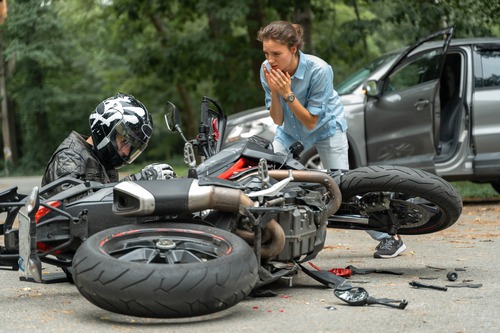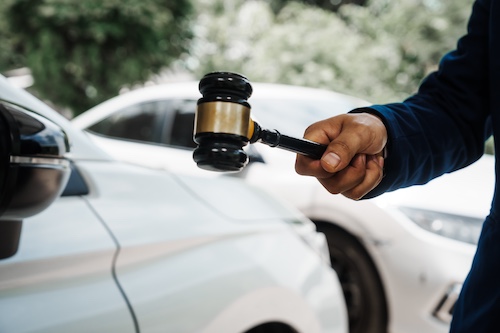At NC Car Accident Lawyers, we are dedicated to supporting individuals across North Carolina who have been affected by vehicle accidents. Our experienced legal team understands the challenges you may face after an accident, including dealing with injuries, insurance companies, and financial burdens. We are committed to providing personalized attention, aggressive representation, and 24/7 availability to help you navigate the legal process and pursue the compensation you deserve.
Lane splitting is a controversial and often misunderstood topic, especially for motorcycle riders in North Carolina. While some see it as a way to move through congested traffic more efficiently, the law in this state makes the practice illegal. Understanding the legal risks and safety concerns tied to lane splitting is critical for any motorcyclist.
In this blog, we explain what lane splitting is, why it is illegal in North Carolina, the risks it creates, how it affects accident claims, and why working with an experienced North Carolina motorcycle accident lawyer is important.
What Is Lane Splitting?
Lane splitting is a riding behavior that often raises questions about legality and safety. In this section, we define it clearly and explain how it differs from similar actions like lane filtering and lane sharing.
Definition of Lane Splitting
Lane splitting happens when a motorcycle rider moves between two lanes of stopped or slow-moving traffic, typically in the same direction. This often occurs during traffic congestion or when other motor vehicles are moving at reduced speeds. The rider moves through gaps between cars, staying within the white dashed lines separating lanes.
This is not the same as using a full lane. In lane splitting, the motorcyclist rides between lanes rather than behind a lead vehicle. It is most common in heavy traffic or during a traffic jam.
Lane Splitting vs. Lane Filtering
Lane filtering refers to a motorcyclist moving between stopped vehicles, usually at intersections or traffic lights. This often happens at lower speeds and in stationary traffic. While both involve moving between cars, filtering typically involves shorter distances and occurs in stopped traffic rather than slow-moving traffic.
Lane Splitting vs. Lane Sharing
Lane sharing is when two motorcycles ride side by side in the same lane. This is legal in many places, including North Carolina, under certain conditions. Lane splitting, however, involves passing other vehicles in the same lane and is a separate act with different legal and safety concerns.
Where Is Lane Splitting Legal?
Lane splitting is currently legal only in a few states. California was the first to permit it, with the California Vehicle Code acknowledging the practice. The California Highway Patrol has also provided lane splitting safety tips to guide motorcyclists.
North Carolina law, by contrast, does not permit lane splitting. Riders must stay in a marked lane and avoid passing other traffic within the same lane. The difference between states like California and North Carolina affects motorcycle riders’ legal obligations and how traffic safety laws are enforced.
Why the Confusion?
Some motorcyclists mistakenly believe lane splitting is legal everywhere. The practice is common in other parts of the world and has been discussed in debates about reducing traffic and improving road safety. However, the North Carolina General Statutes do not allow such movement between lanes. Misunderstanding these laws can lead to legal issues, especially in the event of a motorcycle accident.
Is Lane Splitting Legal in North Carolina?
Lane splitting laws vary by state, and it is important for motorcycle riders in North Carolina to understand how the law applies to them.
Lane Splitting Is Illegal in North Carolina
In North Carolina, lane splitting is illegal. The law requires motorcyclists to stay within a single marked lane. Passing other motor vehicles within the same lane is not allowed. This is clearly stated in North Carolina General Statute § 20-146, which outlines how vehicles must operate within lanes.
The law does not allow motorcycles to move between cars in stopped or slow-moving traffic. This includes congested traffic, traffic jams, and stationary traffic. Riding between two lanes, also called splitting lanes, is not permitted at any speed.
Differences From Other States
Lane splitting is legal in California. The California Vehicle Code and the California Highway Patrol recognize the practice and offer safety tips for riders. North Carolina has not adopted similar traffic laws.
Some riders from other states may assume lane splitting is allowed everywhere. This misunderstanding can lead to legal trouble. Motorcyclists must follow the rules of the road where they are riding, not where they are from.
Why Lane Splitting Remains Illegal
Lawmakers in North Carolina have not approved any bills to legalize lane splitting. Safety concerns are a major reason. Sudden lane changes, vehicle doors opening, and other risks make lane splitting dangerous in traffic. Allowing motorcycles to move between cars increases the chances of rear end collisions and other accidents.
North Carolina focuses on motorcycle safety by requiring riders to operate safely within marked lanes. This approach supports road safety for all drivers, not just motorcycle riders.
What Riders Should Know
Motorcyclists in North Carolina must avoid lane splitting. Even if traffic is slow or stopped, moving between vehicles is against the law. Staying in one lane helps avoid accidents and legal issues.
Dangers and Risks: Why Lane Splitting Is a Legal and Safety Concern
Lane splitting may look like a way to avoid traffic, but it creates serious risks for motorcycle riders and other motorists.
Increased Risk of Accidents
Motorcycles that split lanes often pass close to other vehicles. This increases the risk of sudden lane changes, rear end collisions, and crashes with vehicle doors. In heavy traffic, drivers may not see or expect a motorcycle riding between lanes. A driver changing lanes without signaling can cause a serious motorcycle accident.
Even in slow moving traffic or stopped traffic, there is little room for error. A slight movement by a car can force a rider into another vehicle or off the road. This lack of space creates constant danger for lane splitting riders.
Speed Differential Adds Danger
The difference in speed between the motorcycle and surrounding vehicles is a major safety issue. A high speed differential gives riders less time to react to sudden changes. Traffic flow is often unpredictable in traffic jams, especially when drivers are distracted or frustrated.
If a motorcycle is moving much faster than other traffic, even a small mistake can lead to a crash. The faster the speed compared to other vehicles, the higher the chance of injury.
Limited Escape Routes
Lane splitting limits escape routes. Riders often have nowhere to go if another vehicle swerves or stops suddenly. When a motorcyclist rides in the space between two lanes, they lose the option to maneuver safely out of danger.
This makes it harder to avoid crashes caused by careless lane changes or opened vehicle doors. Riders trapped between cars have little room to recover from a mistake or avoid obstacles.
Impact on Other Road Users
Lane splitting can surprise drivers and lead to unsafe reactions. Other motorists may panic, drift in their lane, or try to block the rider. These reactions can cause chain-reaction accidents and create more danger for all road users.
The behavior also increases tension between drivers and motorcycle riders. It can damage public perception of motorcyclists and hurt efforts to promote road safety.
Why You Need a Motorcycle Accident Attorney in Lane Splitting Cases
Lane splitting is illegal in North Carolina, and engaging in this practice can significantly impact your ability to recover compensation after a motorcycle accident. Understanding the legal implications and securing proper representation is crucial.
Lane Splitting and Contributory Negligence
North Carolina follows a strict contributory negligence rule. Under this law, if you are found even 1% at fault for an accident, you may be barred from recovering any damages. Since lane splitting is not permitted in North Carolina, a motorcyclist who engages in this maneuver may be considered at fault or partially at fault in the event of an accident.
Challenges in Proving Liability
Insurance companies often use the illegal nature of lane splitting to deny claims. They may argue that the motorcyclist’s actions contributed to the accident, making it challenging to pursue a claim, even if another driver also acted negligently. This makes it essential to have a motorcycle accident attorney who can gather evidence, interview witnesses, and build a strong case on your behalf.
How NC Car Accident Lawyers Can Assist
At NC Car Accident Lawyers, we specialize in handling motorcycle accident cases, ensuring that our clients receive the dedicated support they need during this challenging time. Our attorneys understand North Carolina motorcycle laws and are equipped to navigate the complexities of these cases. We provide comprehensive legal support tailored to your specific needs, from helping victims seek compensation to cover medical bills to holding the negligent driver responsible for their behavior.
Steps to Take After a Lane Splitting Accident
- Ensure Safety: Move to a safe location and check for injuries.
- Call Emergency Services: Report the accident to the police and seek medical attention.
- Document the Scene: Take photos of the accident scene, your injuries, and any damages.
- Gather Information: Collect contact and insurance information from all parties involved and any witnesses.
- Avoid Admitting Fault: Do not discuss fault at the scene or with insurance adjusters.
- Consult a Motorcycle Accident Attorney: Contact NC Car Accident Lawyers for a free case evaluation to understand your rights and options.
Contact an Experienced North Carolina Motorcycle Accident Attorney Today!
If you have been involved in a motorcycle accident in North Carolina, particularly one related to lane splitting, the team at NC Car Accident Lawyers is here to help. Our experienced motorcycle accident attorneys understand the complexities of North Carolina traffic laws and are dedicated to protecting your rights. We offer a free case evaluation to discuss your situation and explore your legal options.
Contact us at 864-561-6247 for a free case consultation today!







